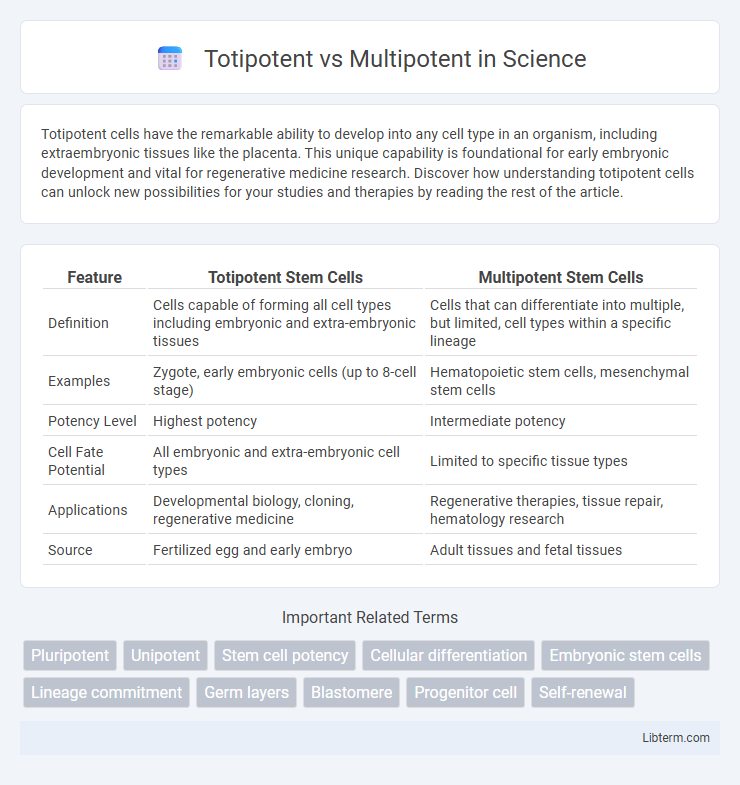Totipotent cells have the remarkable ability to develop into any cell type in an organism, including extraembryonic tissues like the placenta. This unique capability is foundational for early embryonic development and vital for regenerative medicine research. Discover how understanding totipotent cells can unlock new possibilities for your studies and therapies by reading the rest of the article.
Table of Comparison
| Feature | Totipotent Stem Cells | Multipotent Stem Cells |
|---|---|---|
| Definition | Cells capable of forming all cell types including embryonic and extra-embryonic tissues | Cells that can differentiate into multiple, but limited, cell types within a specific lineage |
| Examples | Zygote, early embryonic cells (up to 8-cell stage) | Hematopoietic stem cells, mesenchymal stem cells |
| Potency Level | Highest potency | Intermediate potency |
| Cell Fate Potential | All embryonic and extra-embryonic cell types | Limited to specific tissue types |
| Applications | Developmental biology, cloning, regenerative medicine | Regenerative therapies, tissue repair, hematology research |
| Source | Fertilized egg and early embryo | Adult tissues and fetal tissues |
Introduction to Cell Potency
Totipotent cells possess the ability to differentiate into all cell types, including both embryonic and extraembryonic tissues, making them essential during early embryonic development. Multipotent cells are more specialized, capable of giving rise to multiple cell types within a specific lineage or tissue, such as hematopoietic stem cells producing various blood cell types. Understanding the distinctions between totipotent and multipotent cells is crucial for advancements in regenerative medicine and developmental biology.
Defining Totipotent Cells
Totipotent cells possess the unique ability to differentiate into all cell types, including both embryonic and extraembryonic tissues, enabling the formation of a complete organism. These cells arise during the earliest stages of embryonic development, such as the zygote and initial blastomeres. In contrast, multipotent cells are restricted to generating specific cell lineages related to their tissue of origin.
Characteristics of Multipotent Cells
Multipotent cells possess the ability to differentiate into multiple, but limited, cell types within a specific lineage, such as hematopoietic stem cells generating various blood cells. These cells exhibit high self-renewal capacity while maintaining tissue-specific regeneration potential, contributing to repair and maintenance in adult organisms. Unlike totipotent cells, multipotent cells do not give rise to all cell types, restricting their developmental potency to a defined subset.
Sources of Totipotent Cells
Totipotent cells originate primarily from the zygote and the earliest stages of embryonic development, specifically the morula stage, where each cell retains the ability to develop into any cell type, including extraembryonic tissues like the placenta. In contrast, multipotent cells arise from more differentiated tissues such as adult bone marrow, where they are limited to producing cell types within a specific lineage or tissue family. The unique totipotency of early embryonic cells underpins their unparalleled capacity for complete organismal development, distinguishing them fundamentally from multipotent stem cells.
Origins of Multipotent Cells
Multipotent cells originate primarily from stem cells found in fetal and adult tissues, possessing the ability to differentiate into multiple, but limited, cell types within a specific lineage. Unlike totipotent cells, which can give rise to all cell types including embryonic and extraembryonic tissues, multipotent stem cells specialize as development progresses, contributing to tissue regeneration and maintenance. Their origins trace back to pluripotent embryonic stem cells that gradually restrict their differentiation potential during organismal development.
Functional Differences: Totipotent vs Multipotent
Totipotent cells have the unique ability to differentiate into all cell types, including both embryonic and extraembryonic tissues, enabling the formation of a complete organism. In contrast, multipotent cells are limited to differentiating into multiple cell types within a specific lineage or tissue, such as hematopoietic stem cells generating various blood cells. This fundamental functional difference defines their roles in development and regenerative medicine, with totipotent cells representing the earliest stage of cellular potential and multipotent cells supporting tissue-specific renewal and repair.
Role in Embryonic Development
Totipotent cells possess the unique ability to develop into any cell type, including extraembryonic tissues, making them essential for forming the entire embryo and placenta during early embryonic development. Multipotent cells are restricted to differentiating into a limited range of related cell types, crucial for generating various tissues and organs as the embryo progresses through later developmental stages. The transition from totipotency to multipotency marks a key step in embryogenesis, enabling specialized tissue formation while maintaining developmental plasticity.
Applications in Regenerative Medicine
Totipotent stem cells, capable of differentiating into any cell type including extraembryonic tissues, offer vast potential for creating entire organs and repairing complex tissue damage in regenerative medicine. Multipotent stem cells, restricted to differentiating into a limited range of cell types within a specific lineage, provide targeted therapies such as hematopoietic stem cell transplants for blood disorders and mesenchymal stem cells for bone and cartilage repair. The strategic use of totipotent cells enables broad tissue regeneration, while multipotent cells are crucial for specialized treatments and reducing immune rejection risks.
Ethical Considerations in Stem Cell Research
Totipotent stem cells, capable of developing into any cell type including extraembryonic tissues, raise significant ethical concerns related to the destruction of embryos during extraction. Multipotent stem cells, restricted to differentiating into cell types within a specific lineage, present fewer ethical dilemmas as they are typically derived from adult tissues or cord blood. Ethical considerations center on balancing the potential for groundbreaking medical treatments against the moral implications of embryonic cell use.
Future Directions in Potency Research
Future directions in potency research emphasize harnessing the full regenerative capabilities of totipotent cells for advanced tissue engineering and personalized medicine. Innovations aim to refine the controlled differentiation of multipotent stem cells to improve targeted therapies for degenerative diseases and organ repair. Integration of single-cell sequencing and gene editing technologies accelerates the understanding of potency regulation, paving the way for novel clinical applications.
Totipotent Infographic

 libterm.com
libterm.com